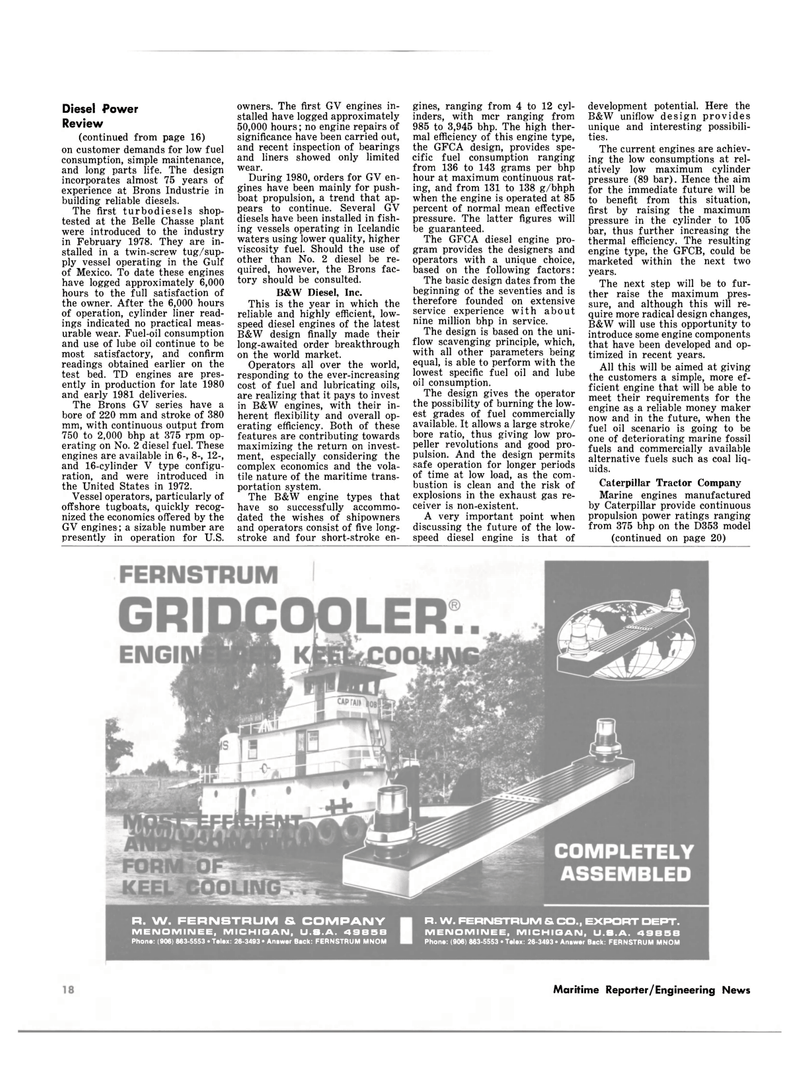
Page 16: of Maritime Reporter Magazine (October 15, 1980)
Read this page in Pdf, Flash or Html5 edition of October 15, 1980 Maritime Reporter Magazine
Diesel Power
Review (continued from page 16) on customer demands for low fuel consumption, simple maintenance, and long parts life. The design incorporates almost 75 years of experience at Brons Industrie in building reliable diesels.
The first turbodiesels shop- tested at the Belle Chasse plant were introduced to the industry in February 1978. They are in- stalled in a twin-screw tug/sup- ply vessel operating in the Gulf of Mexico. To date these engines have logged approximately 6,000 hours to the full satisfaction of the owner. After the 6,000 hours of operation, cylinder liner read- ings indicated no practical meas- urable wear. Fuel-oil consumption and use of lube oil continue to be most satisfactory, and confirm readings obtained earlier on the test bed. TD engines are pres- ently in production for late 1980 and early 1981 deliveries.
The Brons GV series have a bore of 220 mm and stroke of 380 mm, with continuous output from 750 to 2,000 bhp at 375 rpm op- erating on No. 2 diesel fuel. These engines are available in 6-, 8-, 12-, and 16-cylinder V type configu- ration, and were introduced in the United States in 1972.
Vessel operators, particularly of offshore tugboats, quickly recog- nized the economics offered by the
GV engines ; a sizable number are presently in operation for U.S. owners. The first GV engines in- stalled have logged approximately 50,000 hours; no engine repairs of significance have been carried out, and recent inspection of bearings and liners showed only limited wear.
During 1980, orders for GV en- gines have been mainly for push- boat propulsion, a trend that ap- pears to continue. Several GV diesels have been installed in fish- ing vessels operating in Icelandic waters using lower quality, higher viscosity fuel. Should the use of other than No. 2 diesel be re- quired, however, the Brons fac- tory should be consulted.
B&W Diesel, Inc.
This is the year in which the reliable and highly efficient, low- speed diesel engines of the latest
B&W design finally made their long-awaited order breakthrough on the world market.
Operators all over the world, responding to the ever-increasing cost of fuel and lubricating oils, are realizing that it pays to invest in B&W engines, with their in- herent flexibility and overall op- erating efficiency. Both of these features are contributing towards maximizing the return on invest- ment, especially considering the complex economics and the vola- tile nature of the maritime trans- portation system.
The B&W engine types that have so successfully accommo- dated the wishes of shipowners and operators consist of five long- stroke and four short-stroke en- gines, ranging from 4 to 12 cyl- inders, with mcr ranging from 985 to 3,945 bhp. The high ther- mal efficiency of this engine type, the GFCA design, provides spe- cific fuel consumption ranging from 136 to 143 grams per bhp hour at maximum continuous rat- ing, and from 131 to 138 g/bhph when the engine is operated at 85 percent of normal mean effective pressure. The latter figures will be guaranteed.
The GFCA diesel engine pro- gram provides the designers and operators with a unique choice, based on the following factors:
The basic design dates from the beginning of the seventies and is therefore founded on extensive service experience with about nine million bhp in service.
The design is based on the uni- flow scavenging principle, which, with all other parameters being equal, is able to perform with the lowest specific fuel oil and lube oil consumption.
The design gives the operator the possibility of burning the low- est grades of fuel commercially available. It allows a large stroke,/ bore ratio, thus giving low pro- peller revolutions and good pro- pulsion. And the design permits safe operation for longer periods of time at low load, as the com- bustion is clean and the risk of explosions in the exhaust gas re- ceiver is non-existent.
A very important point when discussing the future of the low- speed diesel engine is that of development potential. Here the
B&W uniflow design provides unique and interesting possibili- ties.
The current engines are achiev- ing the low consumptions at rel- atively low maximum cylinder pressure (89 bar). Hence the aim for the immediate future will be to benefit from this situation, first by raising the maximum pressure in the cylinder to 105 bar, thus further increasing the thermal efficiency. The resulting engine type, the GFCB, could be marketed within the next two years.
The next step will be to fur- ther raise the maximum pres- sure, and although this will re- quire more radical design changes,
B&W will use this opportunity to introduce some engine components that have been developed and op- timized in recent years.
All this will be aimed at giving the customers a simple, more ef- ficient engine that will be able to meet their requirements for the engine as a reliable money maker now and in the future, when the fuel oil scenario is going to be one of deteriorating marine fossil fuels and commercially available alternative fuels such as coal liq- uids.
Caterpillar Tractor Company
Marine engines manufactured by Caterpillar provide continuous propulsion power ratings ranging from 375 bhp on the D353 model (continued on page 20)
R. W. FERN STRUM Si COMPANY
MENOMINEE, MICHIGAN, U.S.A. 4985B
Phone: (906) 863-5553 • Telex: 26-3493 • Answer Back: FERNSTRUM MNOM
R. W. FERNSTRUM Sl CO., EXPORT DEPT.
MENOMINEE, MICHIGAN, U.S.A. 49858
Phone: (906) 863-5553 • Telex: 26-3493 • Answer Back: FERNSTRUM MNOM 36 Maritime Reporter/Engineering News

 15
15

 17
17
